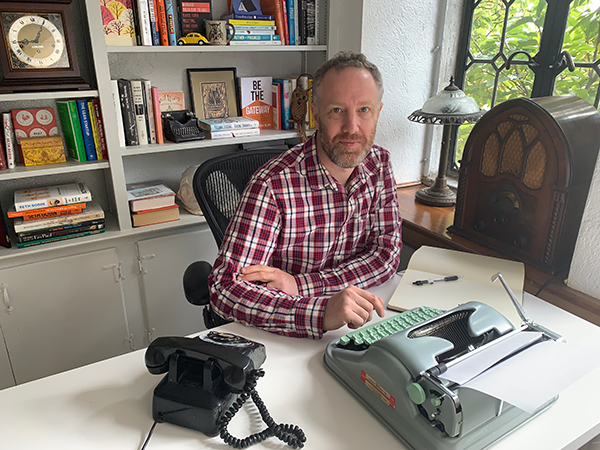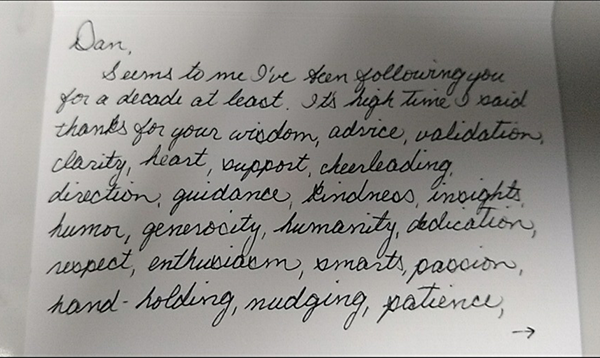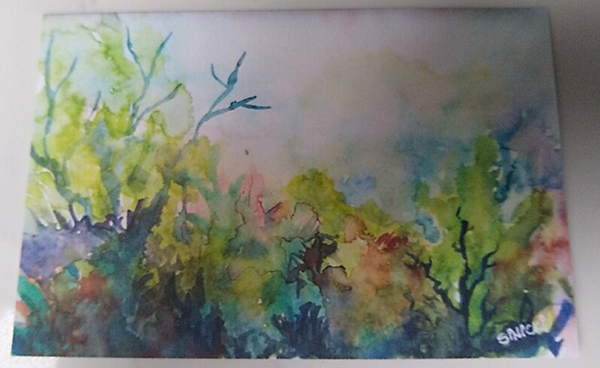I’ve been thinking a lot about the tools that writers have to connect with readers. On any given day, how are you able to connect with people who may love your books and writing?
This past weekend I picked up a vintage radio. It was made in 1931 and is powered by vacuum tubes. In today’s dollars, the radio originally cost nearly $1,200, a dizzying sum when you consider this was in the midst of the Great Depression.
The radio made me consider how the communication and marketing tools that an author has have changed dramatically. Yet, these old fashioned tools still remain very powerful.
Here I am in a pretty typical office setup from 1935, 1955, or even 1975:

(Yes, I collect vintage things!)
If I were a writer in that era hoping to have my manuscript published, hoping that my writing gets in front of readers, what actions could I take?
I could go to the library and look up the names of publishers and agents. Hopefully the books are not out of date. I could then call them, with long distance fees, to ask any questions about how to best query them. I could type up a letter. Then go to the copy store to pay for mimeograph of my manuscript, and send it in a package in the mail. In a few weeks or months, maybe I will hear back.
I can listen in to the radio or TV to get a sense of trends, of what authors are talking about on talk shows, to try to get a sense of how my work fits into the marketplace. I could read newspapers, magazines, books, and journals. But these are all one-way media.
I could attend events, readings, bookstores, libraries and social gatherings to try to meet authors, readers, and those in publishing. Each one requires me to live in an area where this is possible, and to hope I’m in the right room at the right moment to forge a connection with someone.
If the quality of my writing doesn’t grab someone’s attention, or if my social circle is not developed enough, then behind this desk I remain. Yes, I can join local writing groups. I can find a reading at cafes to read excerpts of my work. I can submit essays to publications.
But a distance remains between my writing and my readers without a publisher, without an agent, without a direct means of communication with my readers.
Last week I talked about key elements of author platform: communication and trust. These two things were as essential in 1935 to a writer as they are today.
Nowadays, of course, we have the internet for research, email for direct outreach, social media for connecting with both loose and tight connections, as well as video, websites, newsletters, and so much more.
Yet, “old fashioned” tools still work incredibly well. In fact, sometimes they are even more powerful than newer technology.
I received this letter in the mail this week:

It was from writer Dawn Downey, thanking me for all I have shared for the decade she has followed my work. That’s amazing right? Because of email, the internet, social media, she has been able to connect with me in various ways through an entire decade.
What was even more lovely about this letter is that the card she sent it on featured the artwork of Lisa Sinicki, who Dawn met in my Creative Shift Mastermind! Here is the card:

It was a great reminder that friendships and patrons are forged in these collaborations.
This week I also received an email from writer Faye Westfall who shared:
“You do amazing work with writers. I think it was [more than a decade ago] when I took a course or two from you through Writer’s Digest. I purchased your ebook on blogging and tried my hand at that. Your approach to helping others be successful has kept me reading your Friday emails all these years.”
She then told me about a friend of hers who is a writer, and said, “I think [your book] Be the Gateway will be in her stocking at Christmas.”
For what Dawn and Faye shared with me this week, both were akin to the photo above. Someone taking the time to write a letter to connect. To communicate and build trust.
Oftentimes I consider how the most effective marketing is old-fashioned. The things that connect human beings that are timeless.
I can’t share specific details yet, but for the past few months I have been working with author Leigh Stein on the marketing plan for her new novel which comes out next year.
Key aspects of the marketing campaign could be considered old-fashioned. Things that intentionally don’t scale. Where social media is a secondary component, not primary.
She shared this in her newsletter this week:
My fourth book, Self Care, comes out next summer. I started working on my marketing strategy in August.That’s right: in August.
I’ve been devoting five to ten hours a week to marketing a book that won’t be anywhere near bookshelves for months. The book doesn’t even exist in a physical form yet. It’s way too early for my publisher to assign a marketing or publicity team to my novel (they have sooo many other books ahead of mine to work on.)
I learned a few hard lessons with my last book launch, for my memoir, in 2016, and I want to do better this time.
The marketing plan is comprehensive, but filled with completely outside the box ideas that Leigh is excited about. The goal is to connect her book with readers, but also to create meaningful experiences in the process.
Leigh is publishing a book, but also creating conversations, human connections, supporting others, and continuing to go all-in with her creative vision.
For you, the writer hoping to connect with readers, you have the opportunity to use tools both new and old. To choose a path that fits with your sensibilities, instead of squeezing yourself into someone else’s box, or having to follow “best practices” that don’t resonate with you.
Great marketing is more accessible today than ever before. And even newer marketing tools leverage the best what worked from on old-fashioned means, which is what connects us as human-beings. What draws us in to ideas, to stories, to each other.
Don’t let the tools, new or old, limit you. Connect your writing to readers in ways that are meaningful to you both.
It is so inspiring for me to connect everyday with writers such as Leigh, Dawn, Faye and so many others. Thank you all for your continued support.
Thanks!
-Dan
